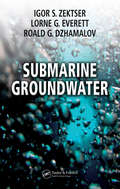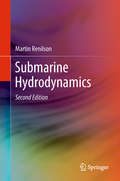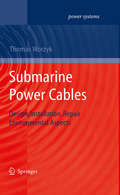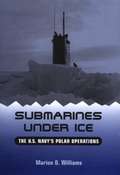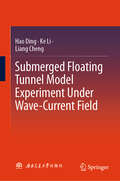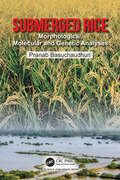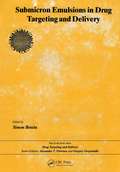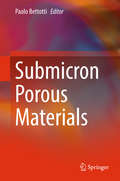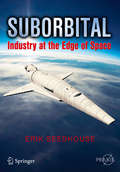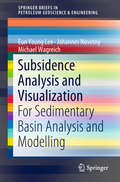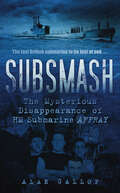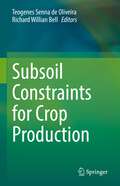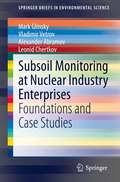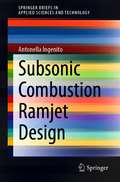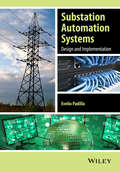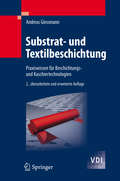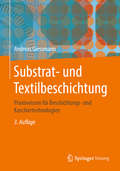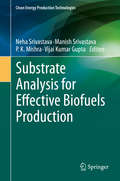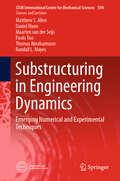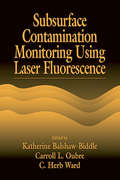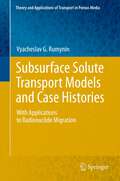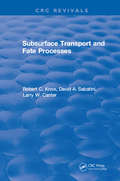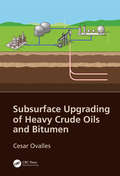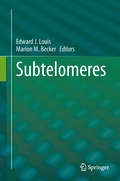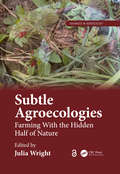- Table View
- List View
Submarine Groundwater
by Igor S. Zektser Lorne G. Everett Roald G. DzhamalovSustainable management of water resources is quickly increasing in importance on a global scale. An important piece of the puzzle is the characterization of marine water and determining its importance to geochemical budgets. To do this, submarine groundwater discharges must be carefully studied. Comprehensively exploring the subject, Submarine G
Submarine Hydrodynamics (SpringerBriefs in Applied Sciences and Technology)
by Martin RenilsonThis book covers specific aspects of submarine hydrodynamics in a very practical manner. The author reviews basic concepts of ship hydrodynamics and goes on to show how they are applied to submarines, including a look at the use of physical model experiments. The book is intended for professionals working in submarine hydrodynamics, as well as for advanced students in the field.This revised edition includes updated information on empirical methods for predicting the hydrodynamic manoeuvring coefficients, and for predicting the resistance of a submarine. It also includes new material on how to assess propulsors, and includes measures of wake distortion, which has a detrimental influence on propulsor performance. Additional information on safe manoeuvring envelopes is also provided. The wide range of references has been updated to include the latest material in the field.
Submarine Power Cables
by Thomas WorzykThe demand for high-performance submarine power cables is increasing as more and more offshore wind parks are installed, and the national electric grids are interconnected. Submarine power cables are installed for the highest voltages and power to transport electric energy under the sea between islands, countries and even continents. The installation and operation of submarine power cables is much different from land cables. Still, in most textbooks on electrical power systems, information on submarine cables is scarce. This book is closing the gap. Different species of submarine power cables and their application are explained. Students and electric engineers learn on the electric and mechanic properties of submarine cables. Project developers and utility managers will gain useful information on the necessary marine activities such as pre-laying survey, cable lay vessels, guard boats etc., for the submarine cable installation and repair. Investors and decision makers will find an overview on environmental aspects of submarine power cables. A comprehensive reference list is given for those who want further reading.
Submarines under Ice: The U.S. Navy's Polar Operations
by Marion D. WilliamsThe author beautifully depicts the 1931 submarine expedition of Sir Hubert Wilkins to explore the Arctic Ocean. The book also shows the rapid advance of science and technology in submarines.
Submerged Floating Tunnel Model Experiment Under Wave-Current Field
by Liang Cheng Ke Li Hao DingThis book conducts research on the overall design of the submerged floating tunnel, structural safety standards, environmental load calculation methods, pipe structure selection, joint structure form, anchoring mode, collision avoidance technology, operation ventilation and disaster prevention, etc., and proposes a preliminary engineering technical plan for the submerged floating tunnel in Qiongzhou Strait. It focuses on the domestic and foreign research status of submerged floating tunnels, model experiment theory and method, experimental system, model design, experimental process, experimental results analysis, and other unique achievements and thoughts. This book is suitable for tunnel engineering scientists, tunnel engineering designers, civil engineers, traffic planning designers, civil engineering students, and teachers. Because submerged floating tunnel is a kind of tunnel structure full of innovation and challenge, research results on suspended tunnels are relatively rare. This book includes the design scheme of submerged floating tunnel, model experiment theory, experimental system, analysis of experimental results, etc., which can provide ideas for the current design of submerged floating tunnel, and also provides useful reference for scholars engaged in the research of basic theory and key technology of submerged floating tunnel and related fields.
Submerged Rice: Morphological, Molecular and Genetic Analyses
by Pranab BasuchaudhuriWater stagnation and submergence are major factors in rice growing. Water stagnation and submergence happen as a result of excessive rainfall or flash floods. The duration of submergence can last several weeks, and the level of water may be as high as 100 cm. This impacts rice yields. This book analyzes different aspects, viz., morphology, physiology, biochemistry and genetics, and reviews the suitability of different varieties for better sustainability and reduction of yield loss. It also reviews the different types of floods, and studies biological changes in indigenous and recently developed rice varieties. There are seven chapters: Introduction, History of floods, Diversity of submergence, Adoptive morphology, Physiological aspects, Molecular and genetic aspects, and Yield and yield-gaps. It is comprehensive with scientific dogma, findings and reasonings for students at universities and researchers.
Submicron Emulsions in Drug Targeting and Delivery
by Simon BenitaIt is anticipated that submicron emulsion and lipid suspension will find numerous and novel medical applications in the near future. The purpose of this multi-authore book is to provide the reader with an up-to-date general overview of submicron emulsions and lipid suspensions (solid lipid nanoparticles) as well as to emphasize the various methods of preparation, characerization, evaluation and potential applications in various therapeutic areas.Leading authors have contributed to this unique book which contains all state of the art and detailed knowledge related to the physico-chemical, pharmaceutical and medical aspects of these most interesting but complex dosage forms, thus making this information easily available to the reader. This book will be of interest to scientists working in the field of drug delivery and targeting in universities as well as in the pharmaceutical, food, cosmetic, veterinary and chemical industries.
Submicron Porous Materials
by Paolo BettottiThis book covers the latest research on porous materials at the submicron scale and inspires readers to better understand the porosity of materials, as well as to develop innovative new materials. A comprehensive range of materials are covered, including carbon-based and organic-based porous materials, porous anodic alumina, silica, and titania-based sol-gel materials. The fabrication, characterization, and applications of these materials are all explored, with applications ranging from sensors, thermoelectrics, catalysis, energy storage, to photovoltaics. Also of practical use for readers are chapters that describe the basics of porous silicon fabrication and its use in optical sensing and drug delivery applications; how thermal transport is affected in porous materials; how to model diffusion in porous materials; and a unique chapter on an innovative spectroscopic technique used to characterize materials' porosity. This is an ideal book for graduate students, researchers, and professionals who work with porous materials.
Suborbital
by Erik SeedhouseThe nascent commercial suborbital spaceflight industry will soon open the space frontier to commercial astronauts, payload specialists, scientists and of course, tourists. This book describes the tantalizing science opportunities to be offered when suborbital trips become routine within the next 12 to 18 months. It describes the difference in training and qualification necessary to become either a spaceflight participant or a fully-fledged commercial suborbital astronaut and it describes the vehicles this new class of astronauts will use. Anticipation is on the rise for the new crop of commercial suborbital spaceships that will serve the scientific and educational market. These reusable rocket-propelled vehicles are expected to offer quick, routine and affordable access to the edge of space along with the capability to carry research and educational crew members. Yet to be demonstrated is the hoped-for flight rates of suborbital vehicles. Quick turnaround of these craft is central to realizing the profit-making potential of repeated sojourns to suborbital heights. As this book outlines, vehicle builders still face rigorous shake-out schedules, flight safety hurdles as well as extensive trial-runs of their respective craft before suborbital space jaunts become commonplace. The book examines some of these 'cash and carry' suborbital craft under development by such groups as Blue Origin, Masten Space Systems, Virgin Galactic and XCOR Aerospace and describes the hurdles the space industry is quickly overcoming en-route to the industry developing into a profitable economic entity. Seedhouse also explains how the commercial suborbital spaceflight industry is planning and preparing for the challenges of marketing and financing and how it is marketing the hiring of astronauts. It examines the role of commercial operators as enablers accessing the suborbital frontier and how a partnership with governments and the private sector will eventually permanently integrate the free market's innovation of commercial suborbital space activities.
Subsidence Analysis and Visualization: For Sedimentary Basin Analysis and Modelling (SpringerBriefs in Petroleum Geoscience & Engineering)
by Eun Young Lee Johannes Novotny Michael WagreichThis book provides a comprehensive introduction to techniques for quantitative subsidence analysis and visualization with example applications. Subsidence analysis is an essential step to understand basin evolution through geologic time and space in the study of sediments and sedimentary basins. Quantifying techniques have been developed and applied in many basin research projects to evaluate total, tectonic and thermal subsidence. They are also a pre-requisite for basin evolution modelling. Recent studies have applied visualization techniques to understand regional subsidence contexts and trends, which confirmed that three-dimensional visualization of the basin subsidence is highly helpful to gain insight into basin evolution. In this book, we show how geoscience and computer science can be effectively combined in advanced basin analysis, especially in terms of basin subsidence. Each type of subsidence analysis is introduced with example applications. In particular we present a study of the Vienna basin using BasinVis, a MATLAB-based program for analyzing and visualizing basin subsidence. Given its breadth of coverage, this book will benefit students in undergraduate and postgraduate courses and provide helpful information for research projects and industry applications.
Subsmash: The Mysterious Disappearance of HM Submarine Affray
by Alan GallopIn April 1951, the disappearance of HM submarine Affray knocked news of the Korean War and Festival of Britain from the front pages. Affray had put to sea on a routine peacetime simulated war patrol in the English Channel. She radioed her last position at 2115hrs on 16 April, 30 miles south of the Isle of Wight - preparing to dive. This was the last signal ever received from the submarine. After months of searching, divers eventually discovered Affray resting upright on the sea bottom with no obvious signs of damage to her hull. Hatches were closed tight and emergency buoys were still in their casings. It was obvious that whatever had caused Affray to sink, and had ended the lives of all those on board, had occurred quickly. Sixty years later, in this compelling maritime investigation, Alan Gallop uses previously top secret documents, interviews with experts and contemporary news sources to explore how and why Affray became the last British submarine lost at sea - and possibly the greatest maritime mystery since the Marie Celeste.
Subsoil Constraints for Crop Production
by Teogenes Senna de Oliveira Richard Willian BellThis book will address the major subsoil physical and chemical constraints and their implications to crop production; Plant growth is often restricted by adverse physical and chemical properties of subsoils yet these limitations are not revealed by testing surface soils and hence their significance in crop management is often overlooked. The major constraints can be physical or chemical. Physical limitations such as poor/nil subsoil structure, sandy subsoils that do not provide adequate water or gravelly subsoils and, etc. On the other hand, chemical constraints include acidity/alkalinity, high extractable Al or Mn, low nutrient availability, salts, boron toxicity and pyritic subsoils. Some of these constraints are inherent properties of the soil profile while others are induced by crop and soil management practices. This aim of this book is to define the constraints and discuss amelioration practices and benefits for crop production. This book will be of interest to readers involved with agriculture and soil sciences in laboratory, applied or classroom settings.
Subsoil Monitoring at Nuclear Industry Enterprises: Foundations and Case Studies (SpringerBriefs in Environmental Science)
by Mark Glinsky Vladimir Vetrov Alexander Abramov Leonid ChertkovThis book is the first comprehensive review of the subsurface monitoring theory and practice. It presents all aspects of a subsurface monitoring system SM-NI to be organized in impacted areas of nuclear industry enterprises. The content of the book covers the whole set of the SM-NI projecting and implementation issues – from the theoretical and regulatory framework, through the description of the sources of impact on geological environment to examples of use the SM-NI to solve environmental problems on the main types of environmentally significant nuclear industry enterprises. Development of the SM-NI was based on long-term research studies including modeling of pollutants transport in the geological environment.The book is intended for a wide range of nuclear industry employees and specialists in environment protection and radiation safety of nuclear industry enterprises. It might be useful for ecologists, students and postgraduates concerned about environment protection in the field of nuclear technology
Subsonic Combustion Ramjet Design (SpringerBriefs in Applied Sciences and Technology)
by Antonella IngenitoThis book presents a step-by-step methodology for the design of ramjet engines. It explores ramjet combustion, provides guidelines on how to size the engines, and discusses performance analysis. The book begins with an introduction to ramjet design, including fundamental definitions in the field. It then discusses ramjet engine performance, and fuels which can be used. Several types of ramjet engines are then explored, and guidelines for their design are presented, including flame holders, injectors, and combustors. Finally, the book concludes with a discussion of the types of materials which should be used for ramjet engines. This book is of interest to engine designers and engineers, researchers, and graduate students, as it collates research in a succinct, clear guide to the issue of designing ramjet engines.
Substation Automation Systems
by Evelio PadillaSubstation Automation Systems: Design and Implementation aims to close the gap created by fast changing technologies impacting on a series of legacy principles related to how substation secondary systems are conceived and implemented. It is intended to help those who have to define and implement SAS, whilst also conforming to the current industry best practice standards. Key features: Project-oriented approach to all practical aspects of SAS design and project development. Uniquely focusses on the rapidly changing control aspect of substation design, using novel communication technologies and IEDs (Intelligent Electronic Devices). Covers the complete chain of SAS components and related equipment instead of purely concentrating on intelligent electronic devices and communication networks. Discusses control and monitoring facilities for auxiliary power systems. Contributes significantly to the understanding of the standard IEC 61850, which is viewed as a "black box" for a significant number of professionals around the world. Explains standard IEC 61850 - Communication networks and systems for power utility automation - to support all new systems networked to perform control, monitoring, automation, metering and protection functions. Written for practical application, this book is a valuable resource for professionals operating within different SAS project stages including the: specification process; contracting process; design and engineering process; integration process; testing process and the operation and maintenance process.
Substrat- und Textilbeschichtung
by Andreas GiessmannDas Buch liefert einen Überblick über Verfahren und Technologien der Beschichtungs- und Kaschierindustrie, die insbesondere bei der Herstellung technischer Textilien zum Einsatz kommen. Der Autor behandelt unterschiedliche Substrate und Beschichtungsmassen, die Verfahrenstechnik sowie Anlagen und Anlagenkomponenten. In der 2. Auflage werden neue, verbesserte Trocknungssysteme sowie die Beschichtung medizinischer Produkte beschrieben. Ferner wurde die aktuelle Auflage um ein Kapitel zur Anwendung von Plastisolen und Additiven ergänzt.
Substrat- und Textilbeschichtung: Praxiswissen für Beschichtungs- und Kaschiertechnologien (VDI-Buch)
by Andreas GiessmannDas Buch liefert einen Überblick über Verfahren und Technologien der Beschichtungs- und Kaschierindustrie, die insbesondere bei der Herstellung technischer Textilien zum Einsatz kommen. Der Autor behandelt unterschiedliche Substrate und Beschichtungsmassen, die Verfahrenstechnik sowie Anlagen und Anlagenkomponenten. In der 2. Auflage werden neue, verbesserte Trocknungssysteme sowie die Beschichtung medizinischer Produkte beschrieben. Ferner wurde die aktuelle Auflage um ein Kapitel zur Anwendung von Plastisolen und Additiven ergänzt.
Substrate Analysis for Effective Biofuels Production (Clean Energy Production Technologies)
by P. K. Mishra Vijai Kumar Gupta Neha Srivastava Manish SrivastavaAs a substrate, cellulose plays a crucial role in the biomass-based biofuel production process, and is essential to enzyme and sugar production. Accordingly, ensuring maximum availability of cellulose for enzyme production and bioconversion for sugar generation is one of the major challenges for sustainable biofuels production. To date there has been extensive research on biofuel production using lignocellulosic biomass, but there is a huge gap when it comes to the critical analysis of cellulose content, structural feasibility, availability, and economic processing, so that it can be converted for enzyme and fuel production at low cost.Consequently, this book discusses the availability of lignocellulosic substrate for biofuel production in light of the challenges that the biofuels industry is currently facing. After identifying the major substrate selection challenges for the practical biofuel production process, the book addresses said challenges by focusing on various issues such as: potential substrates that have high cellulosic content, structural feasibility, and low-cost & effective processing to remedy the structural complexity of biomass structure and create added value. In addition, it covers recent advancements in cellulase production and outlines future prospects.Given its scope, it offers a valuable guide for research students and industry practitioners alike.
Substructuring in Engineering Dynamics: Emerging Numerical and Experimental Techniques (CISM International Centre for Mechanical Sciences #594)
by Randall L. Mayes Daniel Rixen Matthew S. Allen Maarten van der Seijs Paolo Tiso Thomas AbrahamssonThis book reviews the most common state-of-the art methods for substructuring and model reduction and presents a framework that encompasses most method, highlighting their similarities and differences. For example, popular methods such as Component Mode Synthesis, Hurty/Craig-Bampton, and the Rubin methods, which are popular within finite element software, are reviewed. Similarly, experimental-to-analytical substructuring methods such as impedance/frequency response based substructuring, modal substructuring and the transmission simulator method are presented. The overarching mathematical concepts are reviewed, as well as practical details needed to implement the methods. Various examples are presented to elucidate the methods, ranging from academic examples such as spring-mass systems, which serve to clarify the concepts, to real industrial case studies involving automotive and aerospace structures. The wealth of examples presented reveal both the potential and limitations of the methods.
Subsurface Contamination Monitoring Using Laser Fluorescence (Aatdf Monograph Ser.)
by C. H. Ward Katharine Balshaw-Biddle Carroll L. OubreWhile innovative technologies in remediation need to be developed, so do innovative ways of site assessment. This monograph describes the development, testing, and performance of a new laser-induced fluorescence soil probe. A screening tool for site characterization, this probe has the potential to provide an economical, rapid assessment of contaminated sites.Cone Penetrometer testing equipment advances the probe into the subsurface. The probe identifies hydrocarbon classes using a multi-channel excitation-emission matrix. This technique facilitates the collection of significant amounts of subsurface information - surpassing conventional data collection methods - that can be used to rapidly identify areas of concern beneath a site. The technology has significant application for the following:Rapid environmental site assessmentMonitoring remediation programsMonitoring manufacturing processes and industrial waste water operationsSubsurface Contamination Monitoring Using Laser Fluorescence provides comprehensive reference material for researchers and engineers as well as engineering consultants interested in subsurface monitoring techniques or further development of this technology. It describes innovative technology that focuses on finding cost effective solutions for site assessment and remediation.
Subsurface Solute Transport Models and Case Histories
by Vyacheslav G. RumyninThe book addresses the development of the basic knowledge of the subsurface solute transfer with a particular emphasis on field data collection and analysis coupled with modeling (analytical and numerical) tool application. The relevant theoretical developments are concerned mainly with the formulation and solution of deterministic mass-transport equations for a wide range of engineering issues in groundwater quality assessment and forecasting. The book gives many computational examples and case studies drawn from the conducted field investigations. The analyzed problems are as follows: investigation and prediction of groundwater contamination by industrial contaminants and solutions (radionuclides, chloride and nitrate brine) with special focus on the effect of (a) aquifer heterogeneity, anisotropy, and dual porosity, (b) density contrast existing between industrial waste and groundwater, or in density-stratified artesian and coastal groundwater systems; (c) physicochemical interactions that play a major role in retarding (e.g. adsorption) or enhancing (e.g. interactions between dissolved species and mobile colloids) contaminant transport;prediction of the effects of pumping on groundwater quality at wellfields;groundwater dating using stable and radioactive isotopes for prediction and assessment of contamination potential;field and laboratory tests' design and analysis, and monitoring data interpretation;partitioning of surface and subsurface flows using isotope techniques.One of the most essential topics addressed in the book is the migration and fate of radionuclides. Model development is motivated by field data analysis from a number of radioactively contaminated sites in the Russian Federation: near-surface radioactive waste disposal sites and deep-well radioactive waste injection sites. They play a unique role in the advancement of knowledge of the subsurface behavior and fate of many hazardous radionuclides and can be considered as field-scale laboratories. Thus, the book, along with theoretical findings, contains field information, which will facilitate the understanding of subsurface solute transport and the development of a methodology for practical applications to groundwater hydrology.
Subsurface Transport and Fate Processes
by Robert C. KnoxThis book represents the first comprehensive reference volume available on subsurface transport and fate processes. The volume is organized into four sections covering the basics of contaminant properties and how they affect transport and fate, the fundamental processes affecting subsurface transport and fate of contaminants, applications of transport and fate information to various contaminant types, and utilization of transport and fate information for predicting contaminant behavior. Specific topics such as traditional hydrodynamic processes of advection and dispersion, facilitated transport and contaminant flushing, and individual ground water contaminants are also explored in detail. Subsurface Transport and Fate Processes is ideal for environmental and ground water consultants, regulatory agency personnel, and educators in geology, hydrogeology, civil engineering, and environmental engineering.
Subsurface Upgrading of Heavy Crude Oils and Bitumen
by Cesar OvallesHeavy crude oils and bitumen represent more than 50% of all hydrocarbons available on the planet. These feedstocks have a low amount of distillable material and high level of contaminants that makes their production, transportation, and refining difficult and costly by conventional technologies. Subsurface upgrading of heavy crude oils and bitumen is of interest to the petroleum industry mainly because of the advantages compared to aboveground counterparts. This book presents an “in depth” account and a critical review of the progress of industry and academia in the area of subsurface upgrading of heavy, extra-heavy oils and bitumen, as reported in the patent and open literature.
Subtelomeres
by Edward J. Louis Marion M. BeckerNew genes and diversity leading to adaptation and evolution are generated in special areas of genomes. One such area in all eukaryotic genomes and in those prokaryotes with linear chromosomes is the region near the ends of the chromosomes. These telomere-associated sequences or subtelomeres, have different properties than the rest of the genome and are one of the most exciting frontiers left in genomics. This book provides a broad introduction to the field of subtelomeres with detailed information from various fields and systems, covering yeasts and fungi, pathogens and parasites, plants, insects, humans and primates and bacteria with linear chromosomes. Advances in the field as well as continuing challenges are discussed throughout. The mosaic nature of this collection and the everchanging perspectives reflect the nature of subtelomeres themselves. Unlike the core of most genomes, which are conserved and stable over time, subtelomeres are dynamic and polymorphic, so much so that generally no two individuals look alike in these regions. The dynamic nature of the region and the ability to change the copy number, generate diversity and try novel combinations make it the evolutionary tinker's toolbox. In many organisms the genes found in the region are involved in dealing with the environment. In yeasts, different gene families involved in sugar metabolism as well as clumping together are found in subtelomeres and differences in the region may be the reason why some strains are good for baking, others for brewing and why some are pathogenic. In fungal plant and animal pathogens, many of the genes involved in virulence are found here. In humans and primates there are a number of gene families that vary between ends, for example the diverse olfactory receptor genes. Even in bacterial linear chromosomes the region contains genes involved in adapting to their environments. Perhaps the ultimate use of these regions is in parasites where they rapidly adapt and escape from host immune systems through dynamic changes to the proteins exposed to the host's defenses. Such dynamic, polymorphic structures are also found in plants and insects though it is not always clear what the function might be; in some cases they take on the role of end maintenance. The dynamic, polymorphic nature of subtelomeres, where many ends share segmental duplications, is an exciting area for study but also presents a difficult challenge from the technical perspective.
Subtle Agroecologies: Farming With the Hidden Half of Nature (Advances in Agroecology)
by Julia Wright Nicholas ParrottThis book is about the invisible or subtle nature of food and farming, and also about the nature of existence. Everything that we know (and do not know) about the physical world has a subtle counterpart which has been scarcely considered in modernist farming practice and research. If you think this book isn’t for you, if it appears more important to attend to the pressing physical challenges the world is facing before having the luxury of turning to such subtleties, then think again. For it could be precisely this worldview – the one prioritises the physical-material dimension of reality - that helped get us into this situation in the first place. Perhaps we need a different worldview to get us out? This book makes a foundational contribution to the discipline of Subtle Agroecologies, a nexus of indigenous epistemologies, multidisciplinary advances in wave-based and ethereal studies, and the science of sustainable agriculture. Not a farming system in itself, Subtle Agroecologies superimposes a non-material dimension upon existing, materially-based agroecological farming systems. Bringing together 43 authors from 12 countries and five continents, from the natural and social sciences as well as the arts and humanities, this multi-contributed book introduces the discipline, explaining its relevance and potential contribution to the field of Agroecology. Research into Subtle Agroecologies may be described as the systematic study of the nature of the invisible world as it relates to the practice of agriculture, and to do this through adapting and innovating with research methods, in particular with those of a more embodied nature, with the overall purpose of bringing and maintaining balance and harmony. Such research is an open-minded inquiry, its grounding being the lived experiences of humans working on, and with, the land over several thousand years to the present. By reclaiming and reinterpreting the perennial relationship between humans and nature, the implications would revolutionise agriculture, heralding a new wave of more sustainable farming techniques, changing our whole relationship with nature to one of real collaboration rather than control, and ultimately transforming ourselves.
